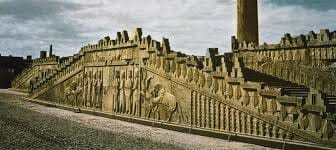Apadana Palace of Darius
The Apadana Palace, built by Darius the Great, is one of the most impressive and significant structures of the ancient world. Located in the city of Persepolis in present-day Iran, this palace served as the ceremonial and administrative center of the Achaemenid Empire, showcasing the grandeur and power of Persian kingship. With its architectural splendor and rich cultural symbolism, the Apadana Palace stands as a testament to the artistic and engineering achievements of the Persian civilization.

Construction of the Apadana Palace began around 515 BCE during the reign of Darius I, who envisioned Persepolis as the new capital of the Achaemenid Empire. The palace complex was designed to embody the ideals of Persian kingship, combining elements of Persian, Assyrian, and Elamite architectural styles.
The focal point of the palace is the Apadana Hall, a vast columned audience hall where the king received foreign delegations and conducted official ceremonies. The hall was constructed on an elevated platform accessed by a grand double staircase adorned with reliefs depicting the diverse subjects of the empire.
The Apadana Hall was supported by 36 columns, each reaching a height of nearly 20 meters. These columns, arranged in four rows, were made of gray limestone and featured intricate capital designs. The columns supported massive wooden beams and a roof, creating an awe-inspiring space capable of accommodating thousands of people.
What is the Apadana of Darius?
The Apadana of Darius, also known as the Audience Hall of Darius, is a significant architectural structure located in the ancient city of Persepolis in present-day Iran. It was built by Darius the Great, the renowned king of the Achaemenid Empire, as part of the larger palace complex in the 5th century BCE.
The Apadana served as the ceremonial and administrative center of the Achaemenid Empire and was the venue where the king received foreign delegations, conducted official ceremonies, and held audiences with his subjects. The name “Apadana” is derived from the Elamite term “apadana,” which means “audience hall.”

The Apadana was designed to reflect the grandeur and power of Persian kingship. It was an elevated platform with a monumental staircase that led to the main hall. The staircase was adorned with intricately carved reliefs depicting the diverse subjects of the empire, showcasing the empire’s ethnic diversity and the tribute system.
The main hall of the Apadana was an awe-inspiring space supported by 36 massive columns arranged in four rows. Each column reached a height of nearly 20 meters and was made of gray limestone. The columns featured elaborate capital designs, adding to the overall aesthetic appeal of the hall. The columns supported wooden beams and a roof, creating a vast covered space capable of accommodating thousands of people.
The exterior walls of the Apadana were adorned with relief sculptures that depicted representatives from various nations of the empire paying homage to the king. These reliefs showcased the empire’s vast reach and the king’s supremacy. They depicted processions of individuals from different ethnic backgrounds, each bearing gifts or offering tribute to the king. These reliefs were not only artistic representations but also served as political and propaganda tools, emphasizing the power and control of the Achaemenid Empire.
The Apadana of Darius was not only an architectural masterpiece but also a symbolic representation of the empire’s cultural and political ideals. The palace complex at Persepolis, including the Apadana, showcased the opulence and refinement of Persian royal life, while the reliefs and sculptures conveyed the religious, cultural, and mythological beliefs of the Persian civilization. It was a visual embodiment of the Achaemenid Empire’s power, wealth, and imperial authority.
Unfortunately, much of the Apadana and the entire city of Persepolis suffered extensive damage during the conquest of Alexander the Great in 330 BCE. The wooden beams and roofing of the Apadana were set ablaze, resulting in the collapse of the grand hall. The sculptures and reliefs were also damaged, with some being looted or destroyed.
Today, the ruins of the Apadana of Darius stand as a UNESCO World Heritage Site and an archaeological marvel. Despite the destruction, the remaining columns and fragments of the reliefs provide valuable insights into the grandeur and significance of the Achaemenid Empire. The Apadana continues to captivate visitors, offering a glimpse into the architectural and artistic achievements of ancient Persia.
What was the purpose of the Apadana Palace?
The Apadana Palace, also known as the Audience Hall of Darius, served multiple purposes within ancient Persian society and the Achaemenid Empire. Here are some of the key purposes of the Apadana Palace:
- Ceremonial Functions: The Apadana Palace was primarily designed as a venue for ceremonial and official functions. It served as a space where the king, such as Darius the Great, received foreign delegations, conducted important state ceremonies, and held audiences with his subjects. It was here that the king displayed his power, authority, and grandeur to visitors and subjects alike.
- Administrative Center: The palace complex, including the Apadana, acted as the administrative center of the Achaemenid Empire. It was a place where the king and his advisers made decisions, received reports, and conducted affairs of the state. The Apadana likely served as a meeting place for important discussions and decisions regarding governance, military campaigns, taxation, and other administrative matters.
- Symbol of Imperial Power: The construction and grandeur of the Apadana Palace were intended to symbolize the might and authority of the Persian Empire and its kings. The impressive architecture, massive columns, intricate reliefs, and lavish decorations were meant to awe and impress visitors, reinforcing the idea of the king’s power and the empire’s strength. The palace complex, including the Apadana, served as a visible representation of Persian imperial authority and dominance.
- Display of Cultural and Ethnic Diversity: The reliefs and sculptures adorning the Apadana Palace showcased the diverse nations and subjects of the Achaemenid Empire. They depicted representatives from various ethnic backgrounds, each bearing gifts or offering tribute to the king. This display of cultural and ethnic diversity conveyed the extent of the empire’s reach and emphasized the king’s control over a vast and diverse population.
- Propaganda and Political Significance: The reliefs and sculptures on the exterior of the Apadana served as political and propaganda tools. They depicted scenes of loyalty, submission, and reverence toward the king, reinforcing the king’s legitimacy and authority. These artistic representations conveyed the empire’s ideology, celebrated the achievements of the king, and promoted loyalty among the subjects.
- Architectural and Artistic Showcase: The Apadana Palace was an architectural masterpiece, showcasing the engineering and artistic skills of ancient Persian craftsmen. The grand columns, elaborate capital designs, and intricate reliefs demonstrated the artistic achievements and aesthetic sensibilities of the Achaemenid Empire. The palace complex, including the Apadana, was a testament to the opulence, refinement, and cultural sophistication of Persian royal life.
Overall, the Apadana Palace served as a multifunctional center within the Achaemenid Empire. It was a place for ceremonies, administration, and the display of imperial power and cultural achievements. It played a crucial role in projecting the might and magnificence of the Persian Empire and its kings to both domestic and foreign audiences.
What is the significance of Apadana in Persepolis?
The significance of the Apadana in Persepolis is multi-faceted and encompasses political, cultural, and historical aspects. Here are some of the key significances of the Apadana in Persepolis:
- Political Symbolism: The Apadana served as a political symbol of the Achaemenid Empire’s power and authority. Its grandeur and architectural magnificence showcased the might of the empire and emphasized the king’s position as the central figure of authority. The palace complex, including the Apadana, visually conveyed the empire’s dominance and control over a vast territory.
- Imperial Administration: The Apadana played a crucial role in the administration of the Achaemenid Empire. It served as a central hub where the king received foreign delegations, conducted official ceremonies, and held audiences with his subjects. As the administrative center, decisions regarding governance, military campaigns, taxation, and other important matters were likely made in the Apadana.
- Cultural Representation: The reliefs and sculptures on the exterior of the Apadana showcased the cultural diversity and achievements of the Achaemenid Empire. They depicted representatives from various nations of the empire, displaying their unique attire, customs, and traditions. This representation of cultural diversity celebrated the empire’s multicultural fabric and served as a cultural statement.
- Propaganda and Ideology: The reliefs and sculptures on the Apadana served as propaganda tools, reinforcing the ideology and legitimacy of the empire. They depicted scenes of loyalty, submission, and reverence toward the king, emphasizing his divine right to rule and promoting loyalty among the subjects. These artistic representations conveyed the empire’s ideology and celebrated the achievements of the king.
- Historical Legacy: The Apadana has immense historical significance as one of the primary structures of Persepolis, the capital of the Achaemenid Empire. Its ruins provide valuable insights into the architectural and artistic achievements of the empire. The Apadana, along with the other structures in Persepolis, stands as a testament to the grandeur and cultural legacy of ancient Persia.
- Archaeological and Touristic Importance: The Apadana, along with the entire city of Persepolis, is recognized as a UNESCO World Heritage Site. Its ruins attract visitors from around the world, offering a glimpse into the architectural, artistic, and cultural achievements of the Achaemenid Empire. The Apadana serves as a focal point for archaeological research, helping scholars understand the ancient Persian civilization and its historical context.
Overall, the Apadana in Persepolis holds immense significance as a political, cultural, and historical symbol. It represents the power and authority of the Achaemenid Empire, showcases its cultural diversity, propagates its ideology, and serves as a tangible connection to the rich history of ancient Persia.
Who destroyed the Apadana?
The destruction of the Apadana and the city of Persepolis is attributed to the conquest of Alexander the Great in 330 BCE. After his successful military campaign against the Achaemenid Empire, Alexander entered the city of Persepolis and ordered the burning and looting of the palace complex, including the Apadana. The exact motivations for this act of destruction are debated among historians.
According to historical accounts, it is believed that Alexander’s decision to destroy Persepolis was a result of a combination of factors. One theory suggests that it was an act of revenge for the Persian invasion and destruction of the Greek city of Athens during the Greco-Persian Wars. Another theory proposes that it was a symbolic gesture to assert his dominance and leave his mark as a conqueror.
Accounts differ on the extent of the destruction caused by Alexander’s forces. Some sources suggest that the Apadana and other structures were severely damaged or even completely destroyed by fire. Others indicate that while there was significant damage, some parts of the palace complex survived the conquest. Regardless, the impact of the invasion and subsequent destruction was substantial, resulting in the ruinous state in which Persepolis exists today.
It is important to note that while Alexander is associated with the destruction of the Apadana and Persepolis, it was not an intentional act of eradication of Persian culture or history. Rather, it was a consequence of the military campaign and the strategic decisions made during the conquest. The ruins that remain today stand as a testament to the once magnificent city and serve as a valuable archaeological and historical site.

